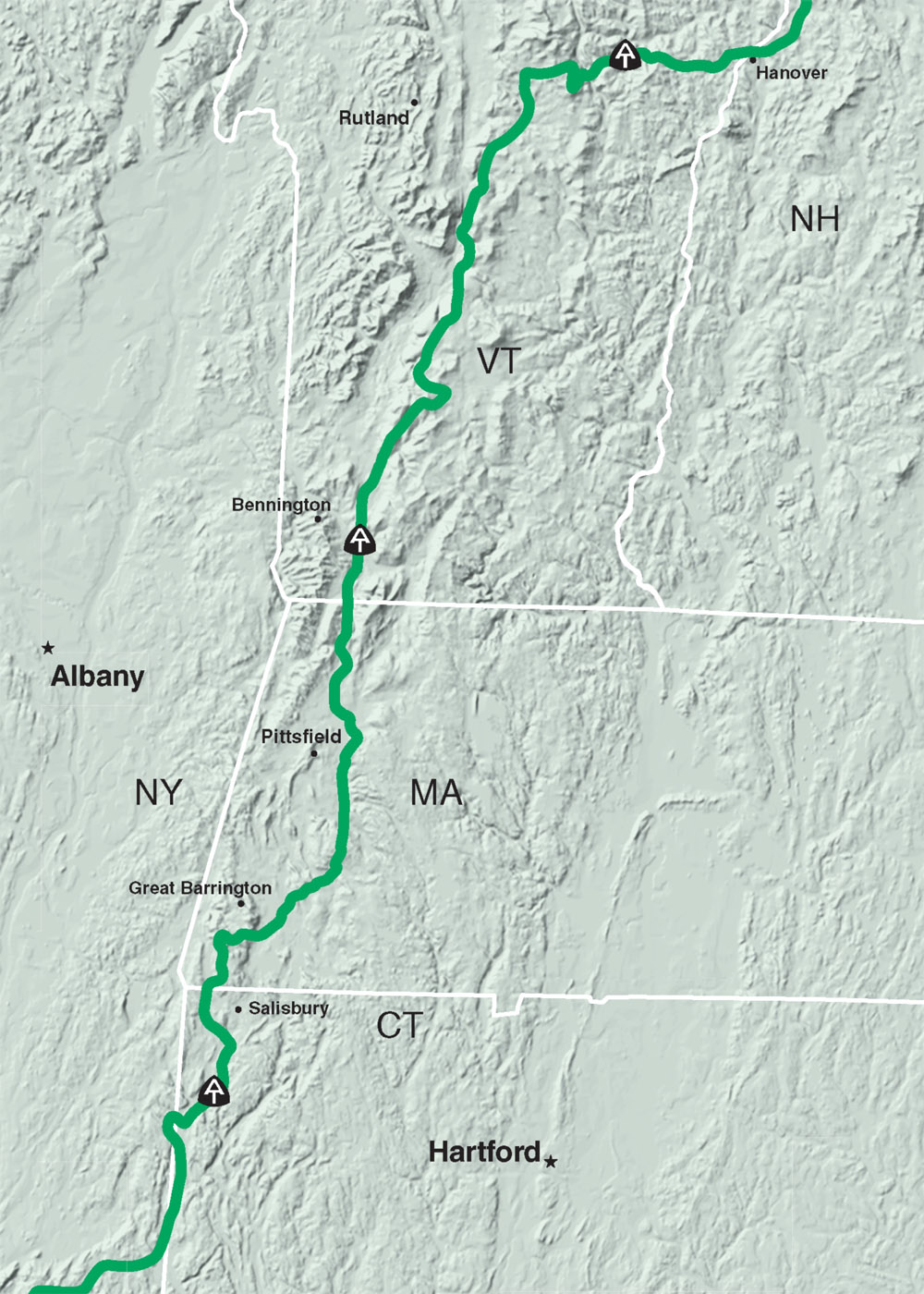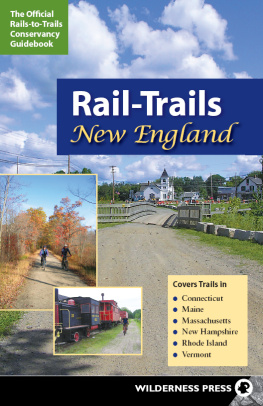Exploring the APPALACHIAN TRAIL

THE SERIES
HIKES IN THE SOUTHERN APPALACHIANS
Georgia North Carolina Tennessee
HIKES IN THE VIRGINIAS
Virginia West Virginia
HIKES IN THE MID-ATLANTIC STATES
Maryland Pennsylvania New Jersey New York
HIKES IN SOUTHERN NEW ENGLAND
Connecticut Massachusetts Vermont
HIKES IN NORTHERN NEW ENGLAND
New Hampshire Maine

A Word of Caution
Readers are advised that trail conditions and locations change frequently due to both natural factors (e.g., erosion) and legal factors (e.g., National Park Service real estate acquisitions). Information in this volume was as accurate as the authors could make it at the time of printing. However, readers should check with their local Appalachian Trail hiking clubs (see Useful Information) for updated information. Readers are also advised that hiking involves some risk of accident and exposure to potentially harmful weather, animals, or impure water. Precautions are advised here under Hiking: The Basics, and the reader uses this guide at his or her own risk. The publisher assumes no liability.
Exploring the Appalachian Trail Series Concept: David Emblidge
Series Editor: David Emblidge
Researcher and Editorial Assistant: Marcy Ross
Fact checkers, 2nd edition: Dave Boone (CT), Jim Pelletier (MA), Dave Hardy (VT)
Copy Editor: Katherine Ness
Book design and cover design: Walter Schwarz, of Figaro, Inc.
Page make-up: Figaro, Inc.
Cartography: Jean Saliter and Lisa Story, of Figaro, Inc. (topo maps); Peter Jensen, of OpenSpace (trail drawing); Kevin Woolley, of WoolleySoft, Ltd. (trail profiles)
Cover photograph: (The Hopper, Mt. Greylock) by Nancy Hecker
Page xii: photograph of Springer Mt.AT plaque (southern terminus) by Doris Gove
Page 26: photograph by David Emblidge
Interior photographs: See credits with each image.
Proofreader: Rodelinde Albrecht
Indexer: Letitia Mutter
2012 David EmblidgeBook Producer
Trail profiles 2012 Stackpole Books
E XPLORING THE A PPALACHIAN T RAIL is a registered trademark of David EmblidgeBook Producer.
Library of Congress Cataloging-in-Publication Data for the first edition
Emblidge, David.
Hikes in southern New England / David Emblidge.1st ed.
p. cm.(Exploring the Appalachian Trail)
ISBN 0-8117-2669-X
1. HikingConnecticutGuidebooks. 2. HikingMassachusettsGuidebooks. 3. HikingVermontGuidebooks. 4. HikingAppalachian TrailGuidebooks. 5. ConnecticutGuidebooks. 6. MassachusettsGuidebooks. 7. VermontGuidebooks. 8. Appalachian TrailGuidebooks. I. Title. II. Series.
GV199.42.C IN PROCESS
917.404'43dc21 97-50085
CIP
ISBN 978-0-8117-1065-7
Printed in the United States
10 9 8 7 6 5 4 3 2





Introduction
W elcome to Exploring the Appalachian Trail.Were glad to have you join us for what promises to be a fine outdoor adventure.
You may not have realized it when you bought or borrowed this book, but if the truth be told, its all about a long-standing love affair. The authors of the hiking guides in this series have been in love with the Appalachian Trail since before we can remember. And weve come to believe that if you truly love something, you will probably act positively to protect it. So when we invite you to join us in walking on the trail, were also inviting you to let yourself be seduced, indeed to go ahead and take the leap into a sweet and enduring love affair of your own. But then be sure to act on the responsibility created as a by-product of that love. Its called service and support. In the section below called Joining Up, you can read more about how each of us can contribute to the health and continuing life of the trail. The Appalachian Trail will give you many gifts. Be sure you give some back.
Unlike other good books about walking the Appalachian Trail, this one will encourage you to slow down, to yield to the many temptations offered up freely by nature and by the social-historical world along the trail. Benton MacKaye, considered by most to be the chief visionary of the early Appalachian Trail, once defined the purpose of hiking on the AT as to see, and to see what you see MacKaye was something of a romantic, and we know he read Emerson, who instructs us all to Adopt the peace of Nature, her secret is patience We cant improve on that.
Our intention is to help you plan and carry out a wide variety of hikes on the nations longest continuously marked footpath, surely one of the most famous walking trails in the world. Well guide you from point A to point B, to be sure, but as far as this book is concerned, its what happens for you between points A and B that counts the most.
If the goal of hiking on the Appalachian Trail is to come home refreshed in body; rejuvenated in mind, and renewed in spirit, then along with the fun of being outside in the mountains, a little work will be required. The most obvious work is of the muscular variety. Less obvious but just as rewarding is the mental kind, and its here that the books in this series will help you the most. The famous world traveler Sven-Olof Lindblad said, Travel is not about where youve been but what youve gained. True travel is about how youve enriched your life through encounters with beauty wildness and the seldom-seen.
In these AT hiking books, well pause to inspect the rocks underfoot and the giant folding and crunching of the entire Appalachian landscape. Well take time to listen to birds and to look closely at wildflowers. We will deliberately digress into the social history of the area the AT passes through, thinking sometimes about industry, other times about politics, and now and then about a well-known or an obscure but colorful character who happened to live nearby Well explore trail towns and comment on trail shelters and campsites (theyre not all alike!). And to help make you a savvy hiker (if you arent already), we will offer up some choice bits of hiker wisdom that just might get you out of a jam or make your load a bit lighter to carry.
This is a participatory book. You will enjoy it and profit from it most if you carry a small notebook and a pen or pencil, if you bring along a camera and perhaps a birding book or a wildflower guide or a guide to some other aspect of the natural world (see the Bibliography for suggestions). Bring a compass and use our maps, or better yet, supplement the maps in this book with the more detailed ones available from the Appalachian Trail Conservancy and other local sources (see page 9 and the Bibliography).


















